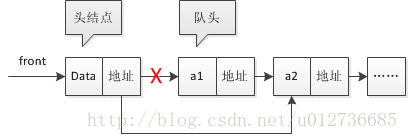队列(queue)
队列(queue):只允许在一端进行插入操作,而在另一端进行删除操作的线性表。
队列是一种先进先出(First In First Out)的线性表,简称FIFO。
允许插入的一端称为队尾,允许删除的一端称为队头
1、抽象数据类型
ADT 队列(Queue)
Data
同线性表。元素具有相同的类型,相邻元素具有前驱和后继关系。
Operation
InitQueue(*Q): 初始化操作,建立一个空队列Q。
DestroyQueue(*Q): 若队列Q存在,則销毀它。
ClearQueue(*Q): 将队列 Q 清空。
QueueEmpty(Q): 若队列Q为空,送回true,否則退回false。
GetHead(Q, *e): 若队列Q存在且非空,用e返因队列Q的队头元素。
EnQueue(*Q,e): 若队列Q存在,插入新元素e到队列Q中并成为队尾元素。
DeQueue(*Q, *e): 刪除队列Q中队头元素,并用e返回其值。
QueueLength(Q): 送回队列Q的元素个教。
endADT
2、循环队列(顺序队列)
下图为队列的假溢出示意图,即下标 0 和 1 的位置还是空闲的,然而指向队尾的指针rear已经出现了数组越界的错误。为了避免这种情况,一般顺序队列也指循环队列。
循环队列:采用环状顺序表来存放队列元素,并用两个指针,其中 front 指针指向队列的队头元素,rear指针指向队尾元素的下一个位置,往队列中加进或取出元素时分别改变这两个变量的计数。当头尾指针(front / rear)指向队列尾的元素(下标:QueueSize-1)时,其加1操作的结果是指向向量的下界0。
2.1 特殊情况的判定——空\满队列
当队列为空或者满的时候都会出现 front == rear 的情况,即无法通过条件 front == rear 来判别队列是”空”还是”满”。
解决这个问题的方法至少有三种:
① 另设一布尔变量或标志变量以区别队列的空和满;
② 保留一个元素空间。约定入队前,测试对尾指针 rear 在循环意义下加1后是否等于 front,若相等则认为队满(注意:rear所指的单元始终为空),此时判空条件仍是 front == rear,判满条件改变;
③使用一个计数器记录队列中元素的总数(即队列长度)。
下文针对②进行讨论。
2.2 实现
队列空的条件:
front == rear
队列满的条件:
(rear + 1)% QueueSize == front
其中,rear为指向队尾元素的下一位置的指针,front 为指向队头元素的指针。QueueSize为队列的最大长度。
通用计算队列长度公式:
(rear - front + QueueSize) % QueueSize
代码实现
注意:传参的形式传址还是传实体对象,实体对象需要用实心点来指向成员,所以判断条件写成 Q.front==Q.rear;传址则为Q->front == Q->rear
#include "stdio.h"
#include "stdlib.h"
#include "io.h"
#include "math.h"
#include "time.h"
#define OK 1
#define ERROR 0
#define TRUE 1
#define FALSE 0
#define MAXSIZE 20 /* 存储空间初始分配量 */
typedef int Status;
typedef int QElemType; /* QElemType类型根据实际情况而定,这里假设为int */
/* 循环队列的顺序存储结构 */
typedef struct
{
QElemType data[MAXSIZE];
int front; /* 头指针 */
int rear; /* 尾指针,若队列不空,指向队列尾元素的下一个位置 */
}SqQueue;
Status visit(QElemType c)
{
printf("%d ",c);
return OK;
}
/* 初始化一个空队列Q */
Status InitQueue(SqQueue *Q)
{
Q->front=0;
Q->rear=0;
return OK;
}
/* 将Q清为空队列 */
Status ClearQueue(SqQueue *Q)
{
Q->front=Q->rear=0;
return OK;
}
/* 若队列Q为空队列,则返回TRUE,否则返回FALSE */
Status QueueEmpty(SqQueue Q)
{
if(Q.front==Q.rear) /* 队列空的标志 */
return TRUE;
else
return FALSE;
}
/* 返回Q的元素个数,也就是队列的当前长度 */
int QueueLength(SqQueue Q)
{
return (Q.rear-Q.front+MAXSIZE)%MAXSIZE;
}
/* 若队列不空,则用e返回Q的队头元素,并返回OK,否则返回ERROR */
Status GetHead(SqQueue Q,QElemType *e)
{
if(Q.front==Q.rear) /* 队列空 */
return ERROR;
*e=Q.data[Q.front];
return OK;
}
/* 若队列未满,则插入元素e为Q新的队尾元素 */
Status EnQueue(SqQueue *Q,QElemType e)
{
if ((Q->rear+1)%MAXSIZE == Q->front) /* 队列满的判断 */
return ERROR;
Q->data[Q->rear]=e; /* 将元素e赋值给队尾 */
Q->rear=(Q->rear+1)%MAXSIZE;/* rear指针向后移一位置, */
/* 若到最后则转到数组头部 */
return OK;
}
/* 若队列不空,则删除Q中队头元素,用e返回其值 */
Status DeQueue(SqQueue *Q,QElemType *e)
{
if (Q->front == Q->rear) /* 队列空的判断 */
return ERROR;
*e=Q->data[Q->front]; /* 将队头元素赋值给e */
Q->front=(Q->front+1)%MAXSIZE; /* front指针向后移一位置, */
/* 若到最后则转到数组头部 */
return OK;
}
/* 从队头到队尾依次对队列Q中每个元素输出 */
Status QueueTraverse(SqQueue Q)
{
int i;
i=Q.front;
while((i+Q.front)!=Q.rear)
{
visit(Q.data[i]);
i=(i+1)%MAXSIZE;
}
printf("\n");
return OK;
}
int main()
{
Status j;
int i=0,l;
QElemType d;
SqQueue Q;
InitQueue(&Q);
printf("初始化队列后,队列空否?%u(1:空 0:否)\n",QueueEmpty(Q));
printf("请输入整型队列元素(不超过%d个),-1为提前结束符: ",MAXSIZE-1);
do
{
/* scanf("%d",&d); */
d=i+100;
if(d==-1)
break;
i++;
EnQueue(&Q,d);
}while(i<MAXSIZE-1);
printf("队列长度为: %d\n",QueueLength(Q));
printf("现在队列空否?%u(1:空 0:否)\n",QueueEmpty(Q));
printf("连续%d次由队头删除元素,队尾插入元素:\n",MAXSIZE);
for(l=1;l<=MAXSIZE;l++)
{
DeQueue(&Q,&d);
printf("删除的元素是%d,插入的元素:%d \n",d,l+1000);
/* scanf("%d",&d); */
d=l+1000;
EnQueue(&Q,d);
}
l=QueueLength(Q);
printf("现在队列中的元素为: \n");
QueueTraverse(Q);
printf("共向队尾插入了%d个元素\n",i+MAXSIZE);
if(l-2>0)
printf("现在由队头删除%d个元素:\n",l-2);
while(QueueLength(Q)>2)
{
DeQueue(&Q,&d);
printf("删除的元素值为%d\n",d);
}
j=GetHead(Q,&d);
if(j)
printf("现在队头元素为: %d\n",d);
ClearQueue(&Q);
printf("清空队列后, 队列空否?%u(1:空 0:否)\n",QueueEmpty(Q));
return 0;
}3、队列的链式存储结构(链队列)及实现
3.1 链队列定义
队头指针( front )指向链队列的头结点,而队尾指针( rear )指向终端结点。非空链队列如下所示。

当队列为空时,front和rear都指向头结点。
结构如下:
#include "stdio.h"
/* QElemType类型根据实际情况而定,这里假设为int */
typedef int QElemType;
typedef struct QNode /* 结点结构 */
{
QElemType data;
struct QNode *next;
} QNode,*QueuePtr;
typedef struct /* 队列的链表结构 */
{
QueuePtr front,rear; /* 队头、队尾指针 */
} LinkQueue;
int main()
{
return 0;
}3.2 入队操作
步骤:
1、根据图,我们先创建一个结点s,QueuePtr s=(QueuePtr)malloc(sizeof(QNode));
2、然后给s的data域赋值e,指针域next赋值null。s->data=e;s->next=NULL; 目的就是让它成为新任队尾元素。
3、前任队尾元素呢?直接让它的指针域指向s就行了。Q->rear->next=s;
4、别忘了把队尾指针重新指向新任队尾s。Q->rear=s;
3.3 出队操作
一般情况:

如果链队列只剩下一个元素的时候,出队则如下图:
3.4 实现
#include "stdio.h"
#include "stdlib.h"
#include "io.h"
#include "math.h"
#include "time.h"
#define OK 1
#define ERROR 0
#define TRUE 1
#define FALSE 0
#define MAXSIZE 20 /* 存储空间初始分配量 */
typedef int Status;
typedef int QElemType; /* QElemType类型根据实际情况而定,这里假设为int */
typedef struct QNode /* 结点结构 */
{
QElemType data;
struct QNode *next;
}QNode,*QueuePtr;
typedef struct /* 队列的链表结构 */
{
QueuePtr front,rear; /* 队头、队尾指针 */
}LinkQueue;
Status visit(QElemType c)
{
printf("%d ",c);
return OK;
}
/* 构造一个空队列Q */
Status InitQueue(LinkQueue *Q)
{
Q->front=Q->rear=(QueuePtr)malloc(sizeof(QNode));
if(!Q->front)
exit(OVERFLOW);
Q->front->next=NULL;
return OK;
}
/* 销毁队列Q */
Status DestroyQueue(LinkQueue *Q)
{
while(Q->front)
{
Q->rear=Q->front->next;
free(Q->front);
Q->front=Q->rear;
}
return OK;
}
/* 将Q清为空队列 */
Status ClearQueue(LinkQueue *Q)
{
QueuePtr p,q;
Q->rear=Q->front;
p=Q->front->next;
Q->front->next=NULL;
while(p)
{
q=p;
p=p->next;
free(q);
}
return OK;
}
/* 若Q为空队列,则返回TRUE,否则返回FALSE */
Status QueueEmpty(LinkQueue Q)
{
if(Q.front==Q.rear)
return TRUE;
else
return FALSE;
}
/* 求队列的长度 */
int QueueLength(LinkQueue Q)
{
int i=0;
QueuePtr p;
p=Q.front;
while(Q.rear!=p)
{
i++;
p=p->next;
}
return i;
}
/* 若队列不空,则用e返回Q的队头元素,并返回OK,否则返回ERROR */
Status GetHead(LinkQueue Q,QElemType *e)
{
QueuePtr p;
if(Q.front==Q.rear)
return ERROR;
p=Q.front->next;
*e=p->data;
return OK;
}
/* 插入元素e为Q的新的队尾元素 */
Status EnQueue(LinkQueue *Q,QElemType e)
{
QueuePtr s=(QueuePtr)malloc(sizeof(QNode));
if(!s) /* 存储分配失败 */
exit(OVERFLOW);
s->data=e;
s->next=NULL;
Q->rear->next=s; /* 把拥有元素e的新结点s赋值给原队尾结点的后继,见图中① */
Q->rear=s; /* 把当前的s设置为队尾结点,rear指向s,见图中② */
return OK;
}
/* 若队列不空,删除Q的队头元素,用e返回其值,并返回OK,否则返回ERROR */
Status DeQueue(LinkQueue *Q,QElemType *e)
{
QueuePtr p;
if(Q->front==Q->rear)
return ERROR;
p=Q->front->next; /* 将欲删除的队头结点暂存给p,见图中① */
*e=p->data; /* 将欲删除的队头结点的值赋值给e */
Q->front->next=p->next;/* 将原队头结点的后继p->next赋值给头结点后继,见图中② */
if(Q->rear==p) /* 若队头就是队尾,则删除后将rear指向头结点,见图中③ */
Q->rear=Q->front;
free(p);
return OK;
}
/* 从队头到队尾依次对队列Q中每个元素输出 */
Status QueueTraverse(LinkQueue Q)
{
QueuePtr p;
p=Q.front->next;
while(p)
{
visit(p->data);
p=p->next;
}
printf("\n");
return OK;
}
int main()
{
int i;
QElemType d;
LinkQueue q;
i=InitQueue(&q);
if(i)
printf("成功地构造了一个空队列!\n");
printf("是否空队列?%d(1:空 0:否) ",QueueEmpty(q));
printf("队列的长度为%d\n",QueueLength(q));
EnQueue(&q,-5);
EnQueue(&q,5);
EnQueue(&q,10);
printf("插入3个元素(-5,5,10)后,队列的长度为%d\n",QueueLength(q));
printf("是否空队列?%d(1:空 0:否) ",QueueEmpty(q));
printf("队列的元素依次为:");
QueueTraverse(q);
i=GetHead(q,&d);
if(i==OK)
printf("队头元素是:%d\n",d);
DeQueue(&q,&d);
printf("删除了队头元素%d\n",d);
i=GetHead(q,&d);
if(i==OK)
printf("新的队头元素是:%d\n",d);
ClearQueue(&q);
printf("清空队列后,q.front=%u q.rear=%u q.front->next=%u\n",q.front,q.rear,q.front->next);
DestroyQueue(&q);
printf("销毁队列后,q.front=%u q.rear=%u\n",q.front, q.rear);
return 0;
}


